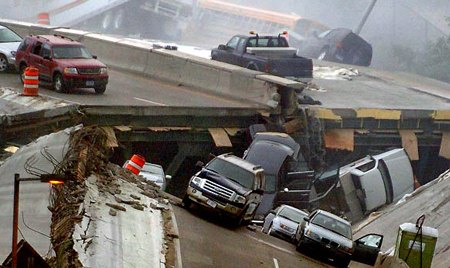BI: How Do We Fix the United States of Disrepair? [VIDEO]

The United States is in a pretty bad spot. Even as the economy recovers from the depressing lows of 2008 and 2009, road, trail, and air travel infrastructure in the United States is failing at an alarming rate. Many underfunded municipalities are even ripping up paved roads and replacing them with gravel as a way to ease budgetary shortfalls.
But is there anything the United States can do to catch up with degrading roads, failing levies, and overflowing airports? Before you pump that cheap dino juice into your Maibatsu Monstrosity today, give this report from Business Insider a watch.
According to BI, some $16 trillion worth of goods travels through the United States each year, and the state of its future movement about the country is precarious at best.
From BI:
Our flood-prevention systems fail too often. Our commutes take too long. Domestic travel is miserable. Our freight system can’t move cargo around smoothly. America used to have the best infrastructure in the world, but now we’re falling behind. Why is that? And what can be done?
In this special report, Business Insider’s Andrew Stern travels by plane, train, and automobile to talk to civil engineers, freight companies, public-policy experts, and authors. The question: How did we become the United States of Disrepair? And can we fix it?

More by Mark Stevenson


































Comments
Join the conversation
36% of highway trust fund money goes to supporting mass-transit and bike paths that support 2% of the traffic. New highways, airports, railways, and port projects must all be approved by EPA (and any State regulatory agencies) for environmental impact, which takes years and costs millions of dollars in consulting and legal fees - which is why Obama found out there were no 'shovel ready' projects to spend his stimulus money on. Projects are forced to pay 'prevailing' wages = union wages for all actual construction work, and set aside some work for minority contractors - all of which inflates building costs. The good news is that roads, bridges, and other transport infrastructure are actually in better shape than most reports indicate, because the authors of most infrastructure reports are engineers and consultants that get their bread buttered from infrastructure spending, and hence has lots of incentive to make things worse than they are. There is plenty of money to fix what needs fixing, its just that it doesn't get spent efficiently or in the right places to do the most good - in other words typical government performance.
It is good to see that the new commenting policies are working. I think it is time for me to fade away again.
Looking at the headline picture, isn't the answer obvious? Stop having earthquakes! :D
It's probably too late for anyone to see this comment, but specifically about the "Our roadway infrastructure is failing!!!!" issue... no, it isn't. Want to talk about bridges? In 1992, 22% of bridges were structurally deficient. By 2012, that number was 11% of bridges. And that's with *increasing* the number of bridges by 30,000 (from 572k to 607k) during that time. So we've cut the number of structurally deficient bridges in half over the past couple decades. It may seem like it from your windshield, but highway departments do not sit around on their asses and do nothing. They know about the state of their infrastructure. They know which bridges need replacing the most, and they prioritize the ones that need action. And despite the industry folks that push for it, I don't think it would do much good to just pour a bunch of money into fixing infrastructure. Who's going to design it? You need good survey, design and support to have usable plans for even repairs and replacements. You need good, experienced contractors to build it in a reasonable amount of time and money. And you need good individual workers to be able to build it. Right now there's an equilibrium of all those parts. You dump a bunch of money in there, and maybe after a decade you've increased the number of good designers and contractors, but in the intervening period, you're going to get a lot of utter crap designed and build and torn down and hopefully fixed. It's not just an issue of dumping money on something, like some would have you believe.